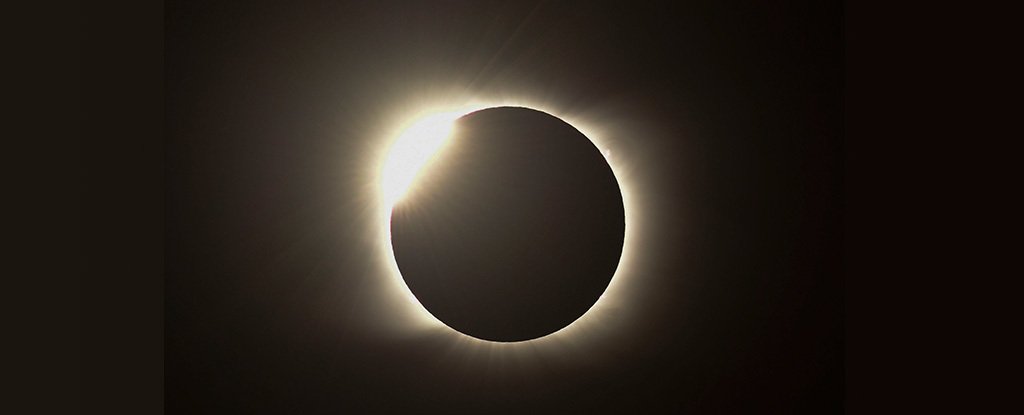
Thousands of people turned their heads to the sky to watch a solar eclipse that lasted about two minutes on Monday as southern Chile and Argentina plunged into darkness.
Heavy rain had threatened to prevent stargazers in Chile from seeing the eclipse, but at the last minute the clouds parted just enough to make the phenomenon partially visible.
“It was beautiful, unique. The truth is, no one had much hope to see it because of the weather and the clouds, but it was unique because it cleared just in time. It was a miracle,” an emotional Matias Tordecilla, 18, told AFP in the city of Pucon on the shores of Lake Villarrica.
“It’s something you not only see with your eyes, but feel with your heart,” added Tordecilla, who traveled with his family for 10 hours to see the solar eclipse.
 The solar eclipse seen in Buenos Aires, Argentina on December 14, 2020. (Muhammed Emin Canik / Anadolu Agency via AFP)
The solar eclipse seen in Buenos Aires, Argentina on December 14, 2020. (Muhammed Emin Canik / Anadolu Agency via AFP)
It was Chile’s second total solar eclipse in the past 18 months.
It struck at 1:00 PM (1600 GMT) as thousands of tourists and residents gathered, hoping that the clouds would clear in time.
“It gave me goosebumps,” said Pucon resident Cinthia Vega.
In Argentine Patagonia, several families and foreigners had set up camp between the towns of Villa El Chocon and Piedra del Aguila in the hope of seeing the solar eclipse.
 A statue’s arm is seen as a solar eclipse takes place in Santiago, Chile on December 14, 2020. (Cristobal Saavedra Vogel / Anadolu Agency via AFP)
A statue’s arm is seen as a solar eclipse takes place in Santiago, Chile on December 14, 2020. (Cristobal Saavedra Vogel / Anadolu Agency via AFP)
Although there was no rain, strong winds threatened to affect visibility.
Despite COVID-19 movement restrictions, nearly 300,000 tourists had arrived in the Araucania region, about 800 kilometers south of the capital, Santiago.
Dozens of amateur and professional scientists have set up telescopes on the slopes of Villarrica volcano – one of the most active in Chile – to observe the phenomenon as the moon passes between the sun and the earth.
 The total solar eclipse as seen from Pucon, southern Chile, on December 14, 2020. (Martin Bernetti / AFP)
The total solar eclipse as seen from Pucon, southern Chile, on December 14, 2020. (Martin Bernetti / AFP)
The solar eclipse would be visible along a 90-kilometer-wide corridor from the Pacific coast in Chile across the Andes mountains to Argentina.
In July 2019, about 300,000 people went to the Atacama Desert in northern Chile, where several observatories are located, to see the previous solar eclipse.
Fight with evil power
Chilean authorities feared that the eclipse would attract large crowds.
There are over 570,000 cases of coronavirus among the 18 million residents with nearly 16,000 confirmed deaths.
Strict controls were announced for areas where the total solar eclipse would be visible, with free movement prohibited both the day before and after.
The event was eagerly awaited by the indigenous Mapuche community of Chile, the largest of this group in the south of the country.
 An indigenous Mapuche family watches the eclipse in Carahue in southern Chile. (Mario Quilodran / AFP)
An indigenous Mapuche family watches the eclipse in Carahue in southern Chile. (Mario Quilodran / AFP)
“Today we were all hoping for a sunny day, but nature gave us rain and at the same time gives us something we need,” said Estela Nahuelpan, a leader in the Mateo Nahuelpan community in the southern city of Carahue.
“In Mapuche culture, the eclipse has different meanings: they talk about ‘Lan Antu’, like the death of the sun and the conflict between the moon and the sun,” she said.
“It refers to the necessary balance that must exist in nature.”
In another tradition, a solar eclipse means the temporary death of the sun during a battle between the star and an evil force known as “Wekufu”.
Indigenous peoples worshiped the sun “like a god,” astronomer Jose Maza told AFP last week.
According to native expert Juan Nanculef, the people would light bonfires and launch “stones and arrows into the air” to aid the sun in its fight against the Wekufu.
Nanculef actually performed a ritual when the eclipse started asking nature to end the rain and make it visible.
“It used to be 100 percent effective,” he said.
This time it seems to have worked just well enough to give people a glimpse of the solar eclipse.
© Agence France-Presse